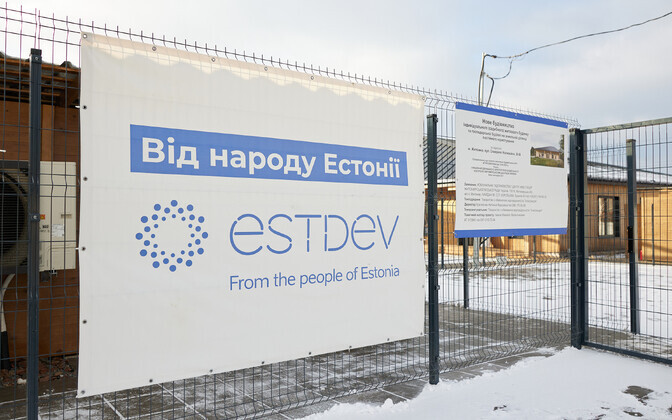Estonia has been actively contributing to Ukraine’s recovery since 2022 and is helping to rebuild the Zhytomyr region, in the north of the country, bordering Belarus. Several projects have already been completed, including reconstructing a kindergarten, a bridge, several group homes for displaced large families and opening a human rights center.
The initial first round of projects has been completed, and during that time, Estonia has also shifted its focus to long-term, sustainable development.
Estonia’s budget until 2027 is €54 million and there are dozens of projects already in progress. These include the development of a hobby hub, the complete renovation of an apartment block for more than 40 families, upgrading medical professionals’ rehabilitation training skills and providing training for municipal authorities about how to apply for international grants.
Margus Gering, ESTDEV’s head of cooperation and development for Ukraine, said there is a lot of enthusiasm in the region and openness to new ideas from local authorities. “They understand that this is their chance to learn from our [Estonia’s] best experiences,” he said.
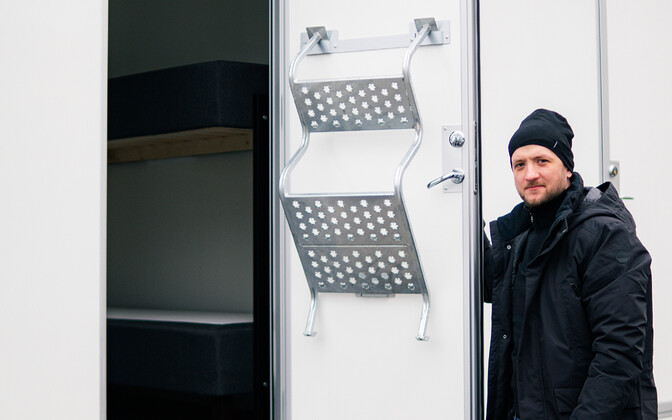 ESTDEV’s Margus Gering showing the interior of the demining camp destined for Zhytomyr oblast in Ukraine Source: Estonian Ministry of Foreign Affairs.
ESTDEV’s Margus Gering showing the interior of the demining camp destined for Zhytomyr oblast in Ukraine Source: Estonian Ministry of Foreign Affairs.
While much of the international community focuses on the frontlines of the conflict, there is a lot of interest from areas such as Zhytomyr where there has historically been less interest. “They have never had experience working with foreign donors or foreign partners,” Gering said.
Authorities are keen to learn from these experiences and to make an impact at the local level, he said, highlighting decentralization reforms in 2017 that gave regional authorities more autonomy.
“Of course, there are some bureaucratic challenges, but nevertheless, the attitude, the body language, the openness for cooperation, this is there,” he added.
Gering said Estonia’s influence in Zhytomyr is clearly felt. From buses driving through the city streets to laptops in schools, Ukrainians are aware of what is being done. He said the team gets dozens of requests for help every week.
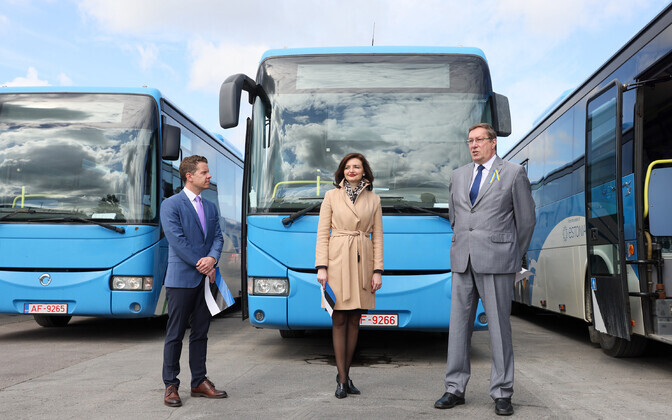 The first five “cloud buses” Estonia is donating to Ukraine were dispatched from Tallinn on Monday. June 13, 2022. Source: Kristi Sits/Ministry of Foreign Affairs
The first five “cloud buses” Estonia is donating to Ukraine were dispatched from Tallinn on Monday. June 13, 2022. Source: Kristi Sits/Ministry of Foreign Affairs
Sharing Estonia’s experience
Projects are developed in cooperation with local municipalities and Ukrainians are involved at all stages. This includes both “reconstruction and recovery”. Gering said construction projects are now more deeply connected with “development and change at the local level.”
One example he gives is the redevelopment of a music school damaged by a Russian missile. A request was made to renovate the school, but after further research, it was found that there were six or seven similar facilities across the city. However, the local authorities were struggling to maintain all the buildings.
Based on the Estonian experience of “optimization in the most positive way,” ESTDEV suggested creating a “hub” and bringing all the services together.
“To build a stronger community, to build stronger services,” Gering said. “We know that there’s no point in building stuff that they can’t maintain in the future.”
Alongside the physical building, a development strategy and roadmap have also been created. “How to have this bigger picture for five, 10 years, how to develop the youth sector [overall],” Gering explained.
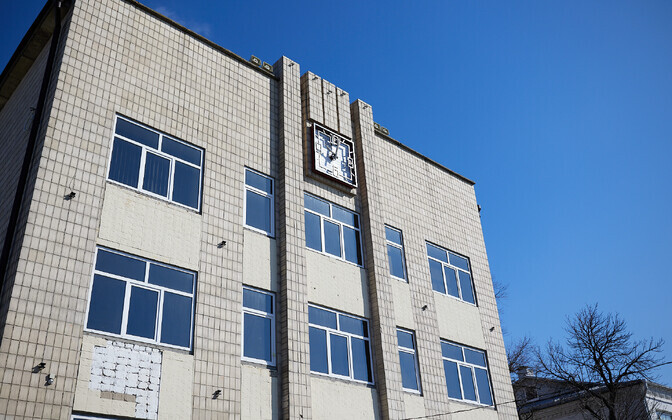 The hobby center to be redeveloped in Zhytomyr region. Source: EstDev
The hobby center to be redeveloped in Zhytomyr region. Source: EstDev
This experience is being trialed as a pilot project, which can be scaled up across the region if it is successful, local authorities have said. A human rights center has already been opened in the hub.
Other future projects will focus on the long-term development of the region, including industry, education and improving strategic thinking. Gering said it is also a priority to help facilitate retraining opportunities to create new “high-skilled” jobs.
For example, Zhytomyr is a heavily forested region, similar to Estonia, and experts are providing advice on how to develop the timber industry.
A new independent coding school will also open in the region, managed by Estonia’s “//Kood” education institutions, founded by the heads of several well-known Estonian startups in Jõhvi. Gering said this is also an “excellent example” of how ESTDEV can help Estonian companies gain a foothold in foreign markets.
“Not a single case” of corruption
The agency and its Estonian partners are involved at all levels of the projects and have oversight of where and how the money is used. Corruption is known to be a problem in Ukraine, but Gering said there have been no problems so far.
“Not a single case,” he said. “When we speak about our job, our projects, not a single case where we had even a feeling of, okay, maybe something strange is happening around [here].”
Speaking about his time as a diplomat in Kyiv before the start of the full-scale invasion, he said there were some “difficult cases” where it was necessary to “defend the interests of Estonian business.”
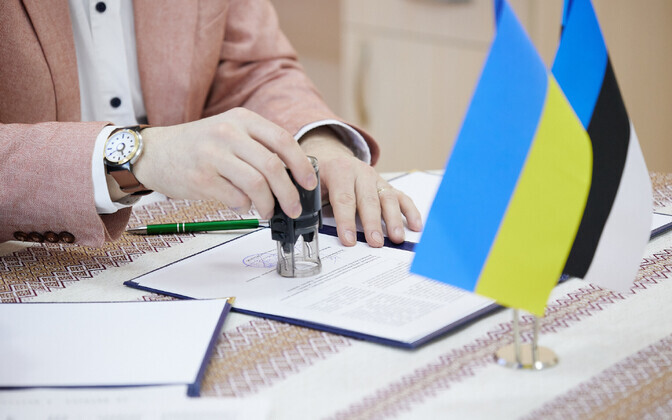 EstDev’s Executive Director Klen Jäärats signing the agreement to build a hobby center in Ukraine. Source: EstDev
EstDev’s Executive Director Klen Jäärats signing the agreement to build a hobby center in Ukraine. Source: EstDev
But now he said there have been no instances of “shady” practices in the tender process.
“I wish to believe that they understand that this is their chance, that we are there to support them,” Gering said. “None of the sides can make any misleading step or mistake that would undermine the whole effort.”
However, problems that ESTDEV has faced are connected to the labor market. Men are needed on both construction sites and the front line. Gering said he knows of instances – but not on ESTDEV projects – where workers were mobilized during their lunch breaks. He says workers can get an exemption from service if they are working on international projects.
Aid sector changing
Estonia has committed to developing projects in Ukraine until at least 2027.
Gering said the Minister of Foreign Affairs expects ESTDEV to replicate and scale up projects. There is also a requirement to find donor money to complement Estonia’s funding from countries friendly to Ukraine.
Estonia has already signed a cooperation agreement for a new group home with Taiwan’s Taipei Mission in Latvia, which is set to be completed by the end of the year.
Gering said several similar agreements with other countries are in development. Estonia’s knowledge is in demand among countries without experience working in Ukraine, he said.
 Kristo Enn Vaga, Taiwan’s Andrew H.C. Lee and Klen Jäärats with the cooperation agreement to build a group home in Uktaine. Source: ESTDEV
Kristo Enn Vaga, Taiwan’s Andrew H.C. Lee and Klen Jäärats with the cooperation agreement to build a group home in Uktaine. Source: ESTDEV
But the trend is also reflective of bigger changes within the international cooperation sector. Countries are becoming less willing to donate money to large multilateral organizations where it is difficult to pinpoint where or how their funds are spent, Gering said.
He added that some countries are moving towards bilateral development projects to showcase what has been done and what has been gained in return for this investment.
As well as Estonia’s efforts, several countries, including Belgium, Denmark, Lithuania, Latvia, France, Germany and Poland, are already underway. Some of them are much bigger than ESTDEV’s projects. For example, Denmark is replacing the water system in the Mykolaiv region.
Success stories
At times, even the Estonians have been surprised by the Ukrainians’ willingness to embrace change, Gering said.
A training session to teach local council officials how to apply for international grant funding was hugely oversubscribed and will be repeated in the future.
Gering also highlights one success story. Estonian businesses are working with local companies when building wooden houses, which Ukraine has no history of producing. But the timber industry can be a good source of technological innovation and employment.
 An Estonian-built wooden group house for foster families in Zhytomyr region. Source: EstDev
An Estonian-built wooden group house for foster families in Zhytomyr region. Source: EstDev
Estonian companies address skills development and introduce the rules and implementation of EU regulations to local companies. “Showcasing how it’s done, helping them to prepare for the next reconstruction projects and tenders,” he said.
One Ukrainian firm then went on to submit its own bid and won a tender for another ESTDEV-funded project. Gering said they completed the project in a “very solid” way. “We’re very satisfied with this company,” he added.
Speaking about the overall situation with ESTDEV’s projects in Ukraine, he said: “We know that they’re tired. We know that they’re exhausted, but they keep pushing. They keep working because their future and their country are at stake.”
Why Zhytomyr region?
In 2022, countries wanting to contribute to Ukraine’s redevelopment and reconstruction were asked by President Volodymyr Zelenskyy to select a single region to work in.
Estonia chose the Zhytomyr region because it already had historic ties with the region and similar features, such as a lot of forests.
“Estonia has been active in Ukraine since 1998. This is our natural partner. We know the country, we know the people, we know what the challenge is. And for us, it was a no-brainer,” said Gering, who was formerly deputy head of the Estonian Embassy in Kyiv.
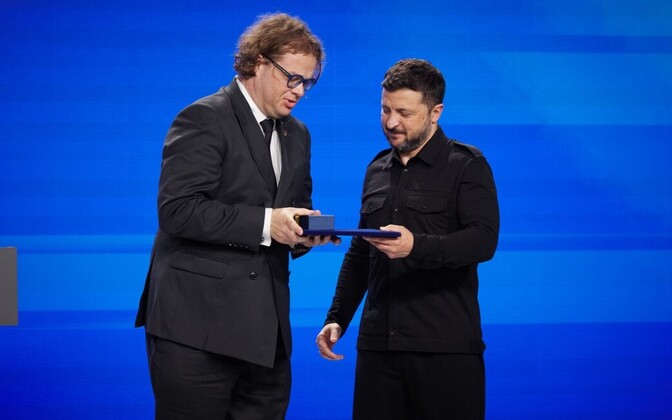 Klen Jäärats, executive ditrector of ESTDEV, accepts the Golden Heart Award from President of Ukraine Volodymyr Zelenskyy. Source: Office of the President of Ukraine
Klen Jäärats, executive ditrector of ESTDEV, accepts the Golden Heart Award from President of Ukraine Volodymyr Zelenskyy. Source: Office of the President of Ukraine
Priorities include restoring war-torn infrastructure, supporting Ukraine’s integration into the EU, accelerating digital development, improving the quality and availability of primary and vocational education, and strengthening democracy.
The city still comes under attack from Russian missiles.
ESTDEV was recently presented with the Golden Heart Award, which recognised Estonia’s contributions to the reconstruction of Ukraine’s Zhytomyr Oblast.
ESTDEV’s Ukraine projects
ESTDEV is working on dozens of projects in Ukraine and with its officials, several are listed below, including those already completed.
Ovruch kindergarten and expansion
The kindergarten in Ovruch was opened in June 2023 and then expanded in February 2024 This was the first reconstruction project Estonia undertook in Ukraine.
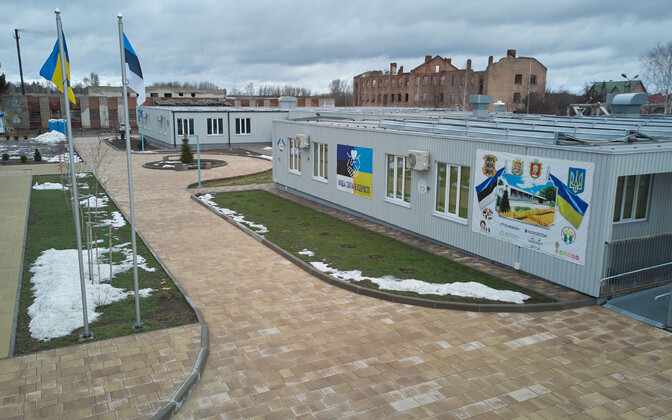 The kindergarten Estonia has rebuild and expanded in Ovruch, Zhytomyr region. Source: EstDev
The kindergarten Estonia has rebuild and expanded in Ovruch, Zhytomyr region. Source: EstDev
Malyn Bridge reconstruction
The partially destroyed bridge in Malyn was reopened in October 2023. Estonia contributed €1 million to the project, a third of the total cost.
On March 6, 2022, Russian forces bombed the area, destroying the bridge which links two parts of the city.
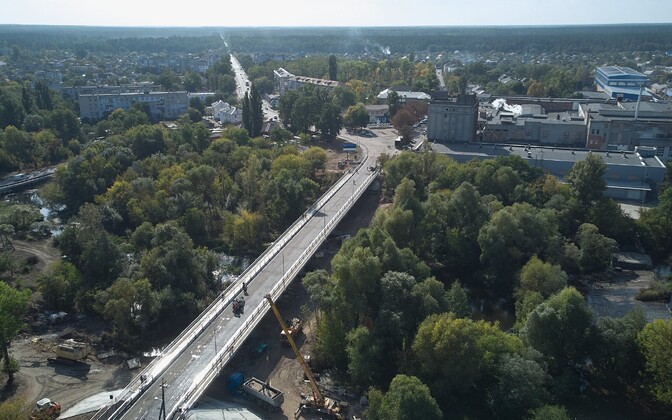 The Malyn Bridge reopened in October 2023. Source: EstDev
The Malyn Bridge reopened in October 2023. Source: EstDev
Group homes
Estonia has built four small family-style group homes for large foster families, who have taken in children orphaned as a result of Russia’s full-scale military invasion. A fifth is under construction.
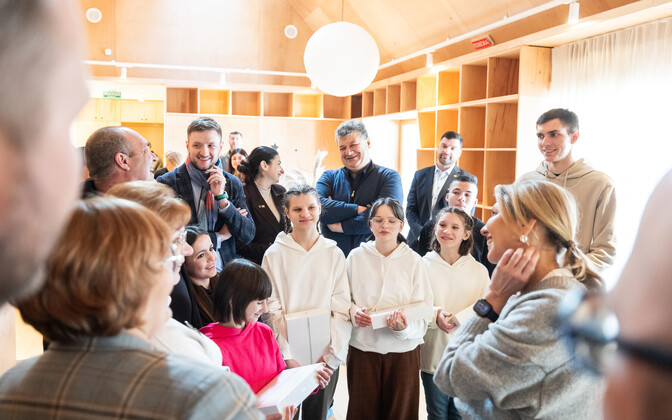
Demining station
In January, Estonia sent a nine-trailer mobile demining camp to Ukraine to help clear ordnance threatening civilian lives, hindering economic development and reconstruction efforts.
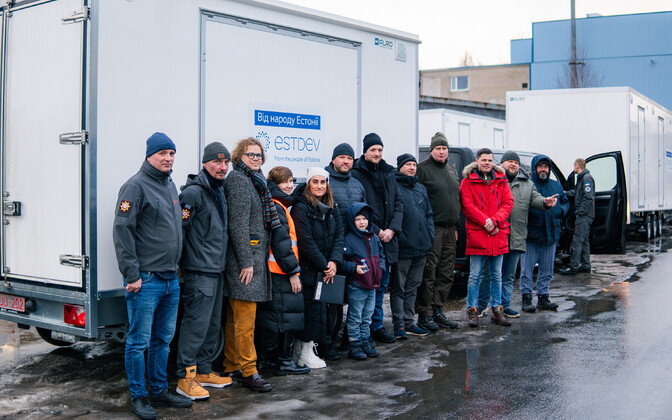 Minister of Foreign Affairs Margus Tsahkna with representatives from ESTDEV and the Estonian Rescue Association in front of the demining camp destined for Zhytomyr oblast in Ukraine Source: Estonian Ministry of Foreign Affairs.
Minister of Foreign Affairs Margus Tsahkna with representatives from ESTDEV and the Estonian Rescue Association in front of the demining camp destined for Zhytomyr oblast in Ukraine Source: Estonian Ministry of Foreign Affairs.
Human Rights Protection Center
In January, Ukraine’s first comprehensive human rights center opened in Zhytomyr. Estonia provided support by funding building renovations as well as training the center’s staff.
The center documents complaints of human rights violations, including those related to the return of children abducted by Russia during the war and prisoner of war exchanges.
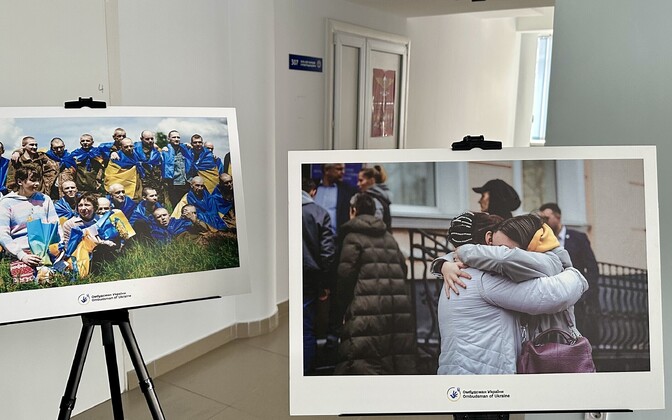 The opening of Ukraine’s first comprehensive human rights center in Zhytomyr. Source: Ministry of Foreign Affairs
The opening of Ukraine’s first comprehensive human rights center in Zhytomyr. Source: Ministry of Foreign Affairs
Training Ukrainian diplomats
In May 2023, Estonia launched a joint training program to prepare Ukrainian civil servants for the European Union’s accession process.
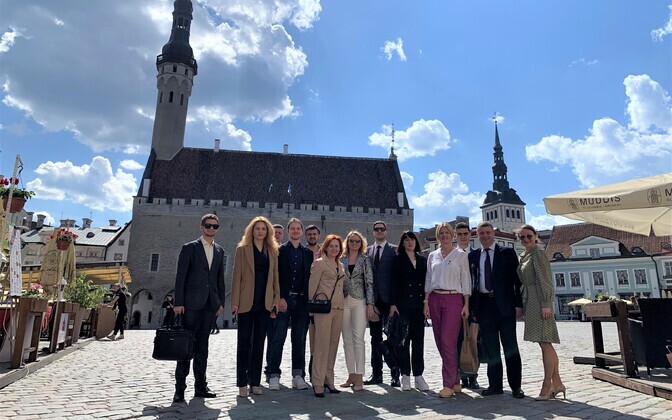 The first 10 Ukrainian civil servants to participate in Estonia’s joint training programme. Source: ESTDEV
The first 10 Ukrainian civil servants to participate in Estonia’s joint training programme. Source: ESTDEV
Police and rule of law reforms
ESTDEV and the Police and Border Guard Board (PPA) are also working with their Ukrainian counterparts to reform the police and prison service and prepare it for EU accession. The PPA has donated dozens of police cars, launched a two-year project to increase police accountability and reduce corruption, and trained 30 officers.
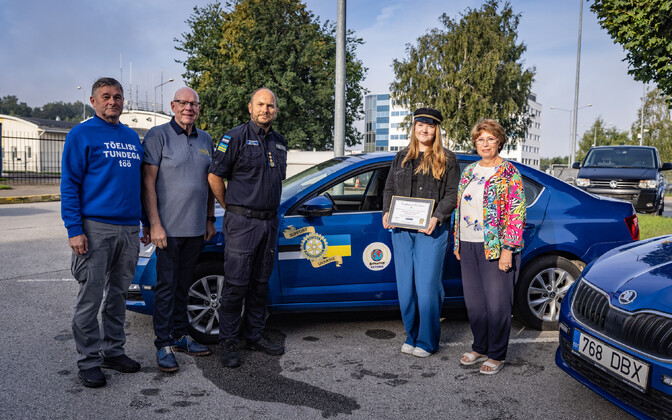 An Estonian police car that has been donated to Ukraine. Source: Reelika Riimand // Police and Border Guard Board (PPA)
An Estonian police car that has been donated to Ukraine. Source: Reelika Riimand // Police and Border Guard Board (PPA)
—
Follow ERR News on Facebook, Bluesky and X and never miss an update!
